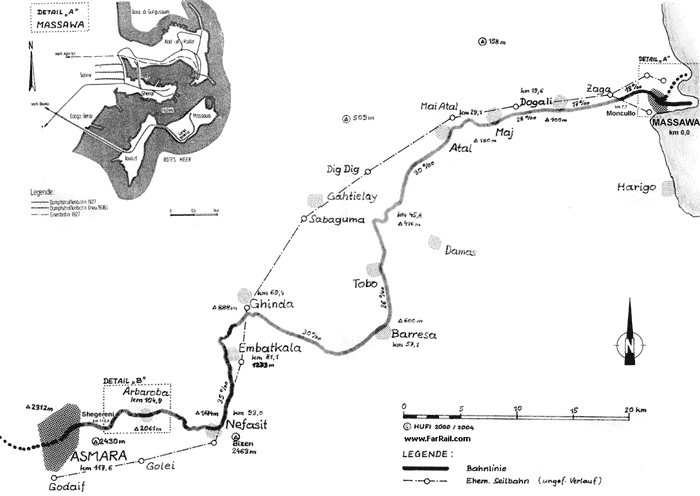articles in the Istanbul newspaper 'İctihad' in September
and December 1913, comparing (not favorably from the
Ottoman perspective) the situations in Italian-occupied
Massawa, in today's Eritrea, and in Hodeidah, on the
opposite Red Sea coast in Ottoman Yemen.
The December article below, 'part one' of this 3-part series,
reflects his observations during a visit to Massawa the
previous July. Arslan's description of life in Hodeidah
will be this series's 'part two' and his analysis of Italian
designs on taking Ottoman Yemen, as the Italians had
taken Ottoman Tripoli two years before, will be 'part
three'.//
Massawa is at upper left and Hodeidah to its southeast on the
opposite shore of the Red Sea. The Farasan Islands are
across from Massawa, off the coast of Jizan.
--------------------------------------------------------------------------------
Red Sea Memoirs
Ethiopia pier, Massawa
When we entered this port aboard the Hıdiv Company's mail ferry
"Tevkifiye", after passing the Dahlak and Nura Islands early in the
morning, I could see that the passengers were quite happy. I chatted
with one of them that boarded at Hodeida - a fellow in Arab garb,
who went by the name 'Salih bin Muhammed', although he was
actually an English officer returning to London via Egypt. He told me
that he had been in Yemen collecting maps for the past 7.5 months.
This fellow said that there were two ice factories in Massawa that ships
come here to take on ice from. As we approached the dock, this Arab-
outfitted Englishman, who spoke fluent Arabic, gave me some details
about Massawa. Using a long telescope, he pointed out an old Moslem
ruin on the right side of the rail line that goes from here to Asmara.
He said that a column among these ruins was an example of a very
old style of architecture.

Massawa-Asmara rail line map.
Once I got off the ferry, I mailed some letters at the post office, where
the calendar read: "28 July". The heat was oppressive - 46-50 degrees
(114-122F) - even though it was not yet noon. The passengers on the
ferry had a right to be happy because, at that moment, ice was being
loaded onto the vessel from the second floor of the post office. The
streets were deserted because in Massawa in the months of June, July
and August, all the shops are closed from 11 to about 3 in the afternoon,
while everyone takes a cold bath in their homes, most of which have
cold-water and cold-air machines.
Order and security in Massawa are quite good, as the Italians have been
able to impose obedience and civilization on the local Ethiopians with
the "Kasas" law over the past 10 years. The policemen are locals but
their bosses are all Italians. The police wear ancient Roman-style
uniforms: large, white feathers on their heads, red jackets, white pants
and either a gun or a cane in their hands. I spotted one policeman
watching the shore line and the other stationed at the pier.

The streets are quiet, clean and safe. The sellers in the markets are
mostly women. The diet is vegetables, fried bird, fish, fish soup and
potatoes. Both the populace and the government treat their animals
very well, with light loads the norm whether pulling carts or carrying
rattan baskets. Rather than horses, Egyptian mules are prevalent,
transporting water in pouches from the dock to the rail station.
There is also a coal depot at Missawa, from where English and
Italian warships patrolling the area take on coal.
Farasan Island coaling station click here for a TNT report
about a German coaling station (1901) on the island group
across the Red Sea from Massawa.
Although Massawa is a small city, this port is quite prosperous and
advanced. The Italians have built the two ice factories that enable
the populace to live in relative comfort, despite the heat. Of course,
the locals were here before the Italians came, but with the Italians
came the ice factories, academies, beautiful buildings and broad
avenues. In any case, it is nearly impossible to work during the heat
of the day but the Italians get the most productivity out of everyone
by allowing for a mid-day break, supplemented by ice and cold water
supplied to all workers and shopkeepers.
//END of PART I//

Hiç yorum yok:
Yorum Gönder